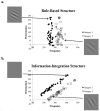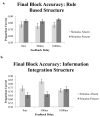Feedback and stimulus-offset timing effects in perceptual category learning
- PMID: 23313835
- PMCID: PMC3560315
- DOI: 10.1016/j.bandc.2012.11.006
Feedback and stimulus-offset timing effects in perceptual category learning
Abstract
We examined how feedback delay and stimulus offset timing affected declarative, rule-based and procedural, information-integration category-learning. We predicted that small feedback delays of several hundred milliseconds would lead to the best information-integration learning based on a highly regarded neurobiological model of learning in the striatum. In Experiment 1 information-integration learning was best with feedback delays of 500ms compared to delays of 0 and 1000ms. This effect was only obtained if the stimulus offset following the response. Rule-based learning was unaffected by the length of feedback delay, but was better when the stimulus was present throughout feedback than when it offset following the response. In Experiment 2 we found that a large variance (SD=150ms) in feedback delay times around a mean delay of 500ms attenuated information-integration learning, but a small variance (SD=75ms) did not. In Experiment 3 we found that the delay between stimulus offset and feedback is more critical to information-integration learning than the delay between the response and feedback. These results demonstrate the importance of feedback timing in category-learning situations where a declarative, verbalizable rule cannot easily be used as a heuristic to classify members into their correct category.
Copyright © 2012 Elsevier Inc. All rights reserved.
Figures





Similar articles
-
The effect of feedback delay and feedback type on perceptual category learning: the limits of multiple systems.J Exp Psychol Learn Mem Cogn. 2012 Jul;38(4):840-59. doi: 10.1037/a0027867. J Exp Psychol Learn Mem Cogn. 2012. PMID: 22746952
-
A computational model of the temporal dynamics of plasticity in procedural learning: sensitivity to feedback timing.Front Psychol. 2014 Jul 2;5:643. doi: 10.3389/fpsyg.2014.00643. eCollection 2014. Front Psychol. 2014. PMID: 25071629 Free PMC article.
-
Comparing the neural basis of monetary reward and cognitive feedback during information-integration category learning.J Neurosci. 2010 Jan 6;30(1):47-55. doi: 10.1523/JNEUROSCI.2205-09.2010. J Neurosci. 2010. PMID: 20053886 Free PMC article.
-
Rule-based category learning in patients with Parkinson's disease.Neuropsychologia. 2009 Apr;47(5):1213-26. doi: 10.1016/j.neuropsychologia.2009.01.031. Epub 2009 Feb 2. Neuropsychologia. 2009. PMID: 19428385 Free PMC article. Review.
-
Human category learning.Annu Rev Psychol. 2005;56:149-78. doi: 10.1146/annurev.psych.56.091103.070217. Annu Rev Psychol. 2005. PMID: 15709932 Review.
Cited by
-
Dopamine dependence in aggregate feedback learning: A computational cognitive neuroscience approach.Brain Cogn. 2016 Nov;109:1-18. doi: 10.1016/j.bandc.2016.06.002. Epub 2016 Sep 3. Brain Cogn. 2016. PMID: 27596541 Free PMC article.
-
An adaptive linear filter model of procedural category learning.Cogn Process. 2022 Aug;23(3):393-405. doi: 10.1007/s10339-022-01094-1. Epub 2022 May 5. Cogn Process. 2022. PMID: 35513744
-
The effect of newly trained verbal and nonverbal labels for the cues in probabilistic category learning.Mem Cognit. 2014 Jan;42(1):112-25. doi: 10.3758/s13421-013-0350-5. Mem Cognit. 2014. PMID: 23868697
-
Acoustilytix™: A Web-Based Automated Ultrasonic Vocalization Scoring Platform.Brain Sci. 2021 Jun 29;11(7):864. doi: 10.3390/brainsci11070864. Brain Sci. 2021. PMID: 34209754 Free PMC article.
-
Multiple stages of learning in perceptual categorization: evidence and neurocomputational theory.Psychon Bull Rev. 2015 Dec;22(6):1598-613. doi: 10.3758/s13423-015-0827-2. Psychon Bull Rev. 2015. PMID: 25917141 Free PMC article. Review.
References
-
- Akaike H. A new look at the statistical model identification. IEEE Transactions on Automatic Control. 1974;19:716–723.
-
- Alexander GE, DeLong MR, Strick PL. Parallel organization of functionally segregated circuits linking basal ganglia and cortex. Annual Review of Neuroscience. 1986;9:357–381. - PubMed
-
- Ashby FG, Alfonso-Reese LA, Turken AU, Waldron EM. A neuropsychological theory of multiple systems in category learning. Psychological Review. 1998;105:442–481. - PubMed
-
- Ashby FG, Ell SW. The neurobiology of category learning. Trends in Cognitive Sciences. 2001;5:204–210. - PubMed
Publication types
MeSH terms
Grants and funding
LinkOut - more resources
Full Text Sources
Other Literature Sources

